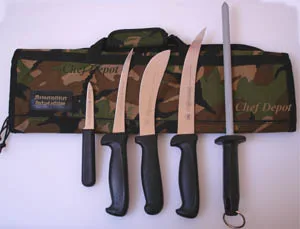Why Precision Skinning Tools Are Vital in Meat Processing
In high-speed UK abattoirs, precision means everything. From hide removal to primary breakdown, skinning is a critical first step that sets the standard for meat quality, hygiene, and efficiency. A dull or poorly shaped skinning knife can not only damage the hide but also increase waste and fatigue for operators.
That’s why facilities across the country—from London to the Scottish Borders—rely on expertly crafted skinning knives UK butchers trust, including specialised models from Victorinox, Giesser, and Dick knives. Investing in quality blades and maintaining them with tools like a steel knife sharpener or an oil stone ensures smoother operations and consistently better yields.
Blade Performance: Features That Matter in the Field
When processing hundreds—or even thousands—of carcasses per day, your blade’s design plays a massive role. The best skinning knives are purpose-built for control, manoeuvrability, and edge retention.
Look for:
- A curved blade with the right belly to follow the hide contours
- Durable, hygienic handles designed for extended use with cut-resistant gloves or chain gloves
- Stainless or high-carbon steel for a razor-sharp finish that holds through repeated cycles
In high-turnover setups, especially those using Kentmaster meat processing tools Manchester-wide, these characteristics help reduce error rates, avoid contamination, and support operator ergonomics.
Standouts in the UK Market: Trusted Knife Brands
There’s a reason seasoned abattoir professionals keep choosing the same names year after year. For performance, longevity, and availability, these brands top the list:
- Victorinox skinning knife UK models: Lightweight, affordable, and surgically sharp—with Fibrox handles that offer grip even when wet
- Giesser knives: Famed for precision-hardened edges and balance, excellent for high-volume trimming and skinning
- Dick knives: These traditional blades offer robust construction and exceptional edge life—great for heavy-duty beef or game processing
Each of these brands also produces complementary tools like siding knives, meat cutting knives, and Victorinox butchers’ knives for seamless workflow integration.
Support Gear: Gloves, Sharpening, and Blades that Work Together
True knife performance goes beyond the blade—it’s about your entire support system:
- Use steel knife sharpeners throughout the day to realign edges during breaks
- Deep-sharpen every few days using an oil stone for long-term maintenance
- Equip staff with cut-resistant gloves, chain gloves, or steel gloves depending on task intensity
- Incorporate handsaw blades and butchers’ knives where large-bone cuts or secondary processing are needed
In high-output environments, smart gear rotation and consistent sharpening routines reduce blade replacement costs and improve staff safety across the board.
Skinning Knife Ergonomics and Operator Fatigue
Modern skinning knives UK suppliers aren’t just focusing on sharpness—they’re designing blades that reduce physical strain over long shifts. Look for:
- Curved, lightweight handles that promote natural wrist movement
- Anti-slip grip patterns that pair well with gloved hands
- Balanced blade weight to reduce wrist torque during hide removal
Facilities prioritising staff wellness report lower turnover and fewer repetitive stress injuries when ergonomically friendly professional butcher knives are used across processing stations.
Blade Rotation Strategies for Large-Scale Abattoirs
In high-capacity processing centres, rotating skinning knives can make or break productivity. A smart blade rotation system includes:
- Knife sets for each operator (typically 3–5 skinning knives in rotation)
- Pre-shift blade checks for sharpness and hygiene
- Mid-shift swaps to prevent fatigue and slowdowns
- End-of-day batch sharpening using Victorinox sharpening tools or wet grinders
This method reduces the risk of blade failure and ensures uninterrupted performance across complex operations—especially when combined with tools from Kentmaster UK and routine use of steel knife sharpeners.
Matching Blades to Animal Type for Best Results
Not every blade suits every species. Here’s a quick breakdown for UK abattoirs:
- Sheep and goats: Use narrow, curved skinning knives for tight angles and fine control
- Beef: Opt for a wider belly blade, often a heavier Dick knife model
- Pigs: Flexible blades with high corrosion resistance, such as those from Giesser
- Game and exotics: Precision blade control using Victorinox or lightweight butchers’ knives
Matching blade geometry to carcass type improves hide quality, boosts yield, and reduces time spent on corrections.
Knife Maintenance & Hygiene Protocols for Compliance
UK food safety standards demand rigorous knife maintenance protocols. Here’s how abattoirs meet those regulations:
- Maintain sharpening stations stocked with steel knife sharpeners and oil stones
- Store blades in labelled racks or sanitiser units between uses
- Replace handsaw blades and clean all meat-cutting knives between carcass types
- Train teams on blade sanitisation, storage, and use of safety gear, including cut-resistant gloves, chain gloves, and steel gloves
Establishing and enforcing a strict maintenance routine also extends blade lifespan—reducing replacement costs and improving product quality.
Training, Upskilling, and Knife Mastery in Abattoirs
Behind every precise hide removal or expertly trimmed cut is a team of professionals who know their tools. As knife technology evolves, so too should the skillsets of those who wield them. That’s why ongoing training is essential in modern UK abattoirs.
- Hands-on blade training: Regular sessions using real carcass setups help staff master the use of skinning knives, siding knives, and meat cutting knives in realistic scenarios.
- Sharpening workshops: Teach operators how to correctly use a steel knife sharpener, care for an oil stone, and preserve the edge on blades like Giesser knives and Victorinox butchers’ knives.
- Safety drills: Reinforce the use of cut-resistant gloves, chain gloves, and steel gloves, especially when switching between tasks or knife types.
- Supplier-led demonstrations: Brands like Victorinox, Dick knives, and equipment experts at Kentmaster UK often offer in-field demos that introduce new tools and best practices.
The better your team understands blade care, anatomy, and knife selection, the more efficient—and safer—your operation becomes. Think of it as investing not just in tools, but in the people who bring those tools to life.
SUMMARY
Excellence in Every Slice
From hide removal to final trim, the modern UK abattoir demands a system of reliable, sharp, and ergonomic tools. Investing in premium skinning knives UK processors trust—like the Victorinox skinning knife UK, Giesser knives, and rugged Dick knives—pays dividends in productivity, safety, and meat quality.
Support these tools with daily attention: use a steel knife sharpener between batches, lean on your oil stone for weekend edge resets, and train your team on handling every blade with confidence. Equip every workstation with essentials like cut resistant gloves, siding knives, and high-powered Kentmaster meat processing tools Manchester built to tackle the toughest carcasses.
Whether you’re processing lamb in the lowlands or beef in the Midlands, combining skill, smart rotation, and top-tier tools transforms your facility into a model of modern meat production.




